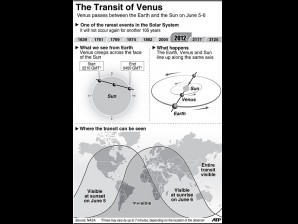Venus blots sun’s surface Wednesday
Venus, the planet named after the Roman goddess of beauty, will put a blemish on the face of the sun Wednesday, a celestial show that will not be seen again for a century.
Filipinos will be able to observe the astronomical phenomenon, called the transit of Venus, on Wednesday morning, from 6:09 a.m. to 12:49 p.m., according to the Philippine Atmospheric, Geophysical and Astronomical Services Administration (Pagasa).
As long as the skies are clear, observers will see Venus appear as a small black “pimple” moving across the face of the sun, scientists said.
“It will look as if there is a tiny black spot, like a small button on the sun,” said Dario de la Cruz, head of Pagasa’s astronomy department.
“This is a rare event. We should take advantage of this,” he said.
Article continues after this advertisementArticle continues after this advertisement
Once in a lifetime
The transit of Venus occurs when the planet passes between Earth and the sun, a once in a lifetime event, De la Cruz said.
The phenomenon is similar to a lunar eclipse, when the moon blocks the sun. But since Venus is farther from Earth, it will appear as a small blot against the fiery face of the sun.
Transits of Venus happen in pairs eight years apart, with more than a century between cycles.
The first transit this century happened in 2004. The event today will be the planet’s second and last transit, De la Cruz said.
Before the 2004-2012 pair, the last pair happened in 1874 and 1882.
Because of the long gaps between occurrences, Filipinos should not miss it as its next appearance will be in 2117, De la Cruz said. “If you miss this, you will not see this again,” he said.
The transit of Venus was valuable to astronomers in the past as this enabled them to measure the size of the sun and the planet, De la Cruz said.
“Of course now, we have equipment for that,” he noted.
Filtered telescope
To avoid permanent eye damage, one must use eclipse glasses, a properly filtered telescope or a strong welding visor when staring directly at the sun.
Those who want to see the celestial phenomenon using high-powered telescopes should make a beeline at the Pagasa Observatory on the University of the Philippines campus in Diliman, Quezon City.
De la Cruz said Pagasa would provide protective sunglasses to watchers to aid them in observing the event.
Spark curiosity
Astronomers across the globe are using the rarity of the moment to spark scientific curiosity among the public, and to document the transit with the latest technology available.
In Hawaii, university astronomers planned viewing at Waikiki Beach, Pearl Harbor and Ko Olina.
At Waikiki, officials planned to show webcasts of the transit as seen from telescopes from volcanoes Mauna Kea on the Big Island and Haleakala on Maui.
Nasa planned a watch party at its Goddard Visitor Center in Maryland with solar telescopes, images from its Solar Dynamics Observatory Mission and expert commentary and presentations. The observatory will produce “Hubble-quality” images, according to Nasa’s website.
James Cook
Groups of scientists from the University of North Texas planned to watch from points in Alaska and Hawaii to recreate the 1769 expedition of British Capt. James Cook, who used the transit to calculate Earth’s distance from the sun.
The scientists will use atomic clocks, GPS and high-end telescopes to take measurements, and will use high-end video gear to capture time-lapse video.
This will be the seventh transit visible since German astronomer Johannes Kepler first predicted the phenomenon in the 17th century.
Ordinary star
“The Venus transit really brings home to us, in a unique way, how ordinary our sun is. It’s just another star,” said scientist and author Mark Anderson.
“There’s something very humbling out of this experience. We are another planet in orbit around another star in another galaxy in another corner of the universe. It really brings it home to us,” Anderson said.
Latest celestial treat
The transit of Venus is the latest celestial treat for Filipino sky watchers. On Monday, observers were able to witness a partial lunar eclipse, in which a third of the moon was covered by Earth’s shadow.
Last month, astronomy enthusiasts were treated to another rare event, the annular solar eclipse. The phenomenon, which was visible on the early morning of May 21 showed the moon partially blocking the sun, making it appear like a ring of fire. The annular solar eclipse will be seen again in 2030. With reports from AP and Reuters
Originally posted: 2:04 pm | Tuesday, June 5th, 2012
